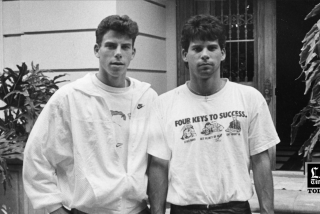Megan’s Law Is Put to Test as Towns Bounce Child Molesters
- Share via
Is there any community in America without children? A place with no schools or day care centers, no apartment buildings and homes with families? Is there a place where children don’t visit their grandparents or play outside in the streets or parks?
Is there, in short, a community where people would not be afraid to have a convicted child molester for a neighbor?
With the advent of Megan’s Law, which allows police to alert neighbors to the molesters in their midst, the question is being put to the test throughout California and all over the country.
In case after case, once people have been told that a convicted child molester lives in their neighborhood, predictably, they have wanted him to leave. Pelted by public outrage, bullhorn-assisted demonstrations in front of their homes and bomb threats on the telephone, the molesters have fled to another community--where residents then have tried to run them out of town.
Is this how Megan’s Law is supposed to work? Are child molesters destined to bounce from one community to the other?
Legal theorists, sociologists and criminologists debate the question, but to others, particularly those who find themselves living next door to convicted sexual predators, the answers are as stark and simple as common sense: Yes, this is how Megan’s Law is supposed to work. And no, there is no place for the repeat child molester.
In Orange County, police have notified neighbors about three convicted sex offenders living nearby, and two other men with molestation convictions have been identified by anonymous fliers.
*
Sidney Landau, a twice-convicted child molester, was forced out of Placentia and Fullerton. Convicted molester Mark W. Mahoney left the city of Orange after police notified residents of his presence. James Lee Crummel’s landlords evicted him from a Newport Beach condominium after police told the community of Crummel’s convictions for attacking, molesting and kidnapping.
The quandary over what to do with sex offenders is not lost on the protesters trying to drive them out.
“It’s a Catch-22,” said Don Redington, a Newport Beach man who lives four doors down from Crummel.
While Megan’s Law is proof that the political system can use grass-roots outrage to create public safety laws, it also highlights the system’s failure, Redington said.
“It failed because there’s nothing we can do about those people, except push them to the next community,” Redington said. “And nobody wants this man in their community.”
Landau’s attorney, T. Matthew Phillips, said he was caught off guard by the vehemence that chased Landau from one city to another.
“I expected parents to express their outrage, and I expected parents to ask why is he not still in jail,” Phillips said. “I expected teenagers to throw eggs at the house, and I expected them to ask his modus operandi.
“But I never expected this. You would think parents would be able to understand that child molesters live among us, murderers live among us, and bank robbers live among us,” Phillips said. “They get out of jail.”
Backers of Megan’s Law say they expected parents to watch over their children more carefully when they knew that a child molester was in their neighborhood.
“It was not supposed to create a peripatetic group of pedophiles,” said Geoffrey Berman, the lawyer for the family of Megan Kanka, the New Jersey child for whom the law is named. Seven-year-old Megan was raped and murdered by a molester who lived across the street from her, unbeknownst to her parents.
“But all the polls show the public is strongly in favor of Megan’s Law,” Berman said. “Ultimately, I assume these individuals will find a community where they create a lesser amount of fear, and that’s where they’ll live,” he said.
Public sympathy for victims of horrific crimes does not necessarily lead to good public policy, said Elizabeth Semel, a board member of the National Association of Criminal Defense Lawyers.
Megan’s Law is “an orchestrated train wreck,” Semel said. “The difference between what people want because it makes them feel like something is being done, and truly protective measures, is a chasm.
“But any time you’re talking about denying victims what they want, politicians are terrified,” she said.
Missing from Megan’s Law is a coherent strategy for what a community should do after notification, said Bonnie Bucqueroux, executive director of the Michigan Victims Alliance and former associate director for the National Center for Community Policing.
“I think we thought we were looking at one or two people coming back into our communities, but what are we going to do with hundreds, and over time, potentially thousands of people who are child molesters?” Bucqueroux asked.
Rather than exiling child molesters, the Rev. Kibbie Ruth advises communities to focus on the measures that they can take to keep children safe.
“The questions are how can we as parents learn to communicate with each other and with our children in a way that’s not fear-driven,” said Ruth, executive director of the Pastoral Center for Abuse Prevention in San Mateo. “What are some basic things we can do in the community honoring [molesters’] human rights and at the same time protecting our children? Actually, there’s a lot we can do.”
Neighborhoods can create homes that are recognized safe harbors for children, she said. They can enlist the help of senior citizens to watch streets when children leave school. And without anger and violence, parents can let the child molesters know that everyone is watching them.
This is the approach Ruth takes with churches from throughout the state that call her after Megan’s Law has revealed that a child molester is part of a congregation.
Asked for the names of churches that have successfully integrated molesters into their congregation, Ruth sighed and said, “I don’t know any.
“There’s usually one or two vigilantes who make it so uncomfortable that they just keep changing churches,” she said.
To many of the protesters, the solution to the dilemma over convicted child molesters is to lock them up forever.
*
But if Megan’s Law has shed light on anything besides the addresses of a handful of molesters, it has revealed the gap between the punishments child molesters typically receive and the punishments the public believes they deserve.
According to the state Department of Corrections, the average sentence meted out to child molesters is 41 months and the average sentence served is 21 months.
Everyone interviewed recommended against lifetime incarceration for all but the most violent molesters.
Berman, the Kankas’ attorney, and other legal experts suggested that the threat of lifetime sentences could exacerbate the danger molesters pose, prompting them to possibly kill their victims, hoping to leave no witnesses to their crimes.
Also, it would be unfair, said Christopher Slobogin, a criminologist at the University of Florida.
“It’s very difficult to predict recidivism, and it wouldn’t work unless you’re willing to put away a lot of people who won’t [molest again] to make sure you put away those who do,” Slobogin said.
But even many legal and psychiatric experts question the current sentencing practices, wondering how violent molesters who have kidnapped or even killed their victims are free men.
“When you have a history of violence or potentially murder, you wonder what the guy is doing out anyway,” said Jerome G. Miller, clinical director of the Augustus Institute in Alexandria, Va.
Miller, who has treated more than 500 pedophiles, also is the federally appointed administrator charged with overhauling the Washington, D.C., child welfare system.
Community notification laws will not stop truly compulsive, violent molesters, he said, and borderline pedophiles who need adult association and acceptance to strengthen their resolve to avoid children will receive just the opposite if they become the focus of community outrage.
“One of the things that drives pedophiles is a sense of isolation,” Miller said. “They live in a trance-like world where they don’t talk to others and get totally into their fantasies. If they don’t have friends or associations, it will push some who aren’t violent into the corner.”
Also, given that 90% of molesters were abused--usually by a relative or friend of the family--society would have to acknowledge a culture of rampant incest if it truly wanted to protect children, Miller said.
It is easier for everyone, he said, to target the symbolic “monster” in our midst.
Megan’s Law may provide the close neighbors of a molester with information they want, Kibbie agreed, but society in general is only getting a scapegoat.
“We’re literally practicing the old religious tradition of scapegoating,” she said. “That ritual, of heaping all of society’s wrongs onto a goat and sending him into the wilderness to die had wonderful significance at the time, but it’s just wrong to do that to a human being.”
Times staff writer Geoff Boucher contributed to this story.
More to Read
Sign up for Essential California
The most important California stories and recommendations in your inbox every morning.
You may occasionally receive promotional content from the Los Angeles Times.










